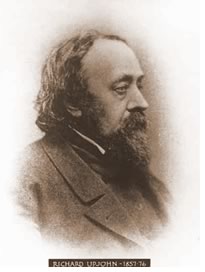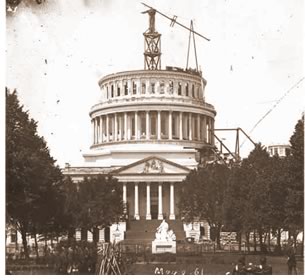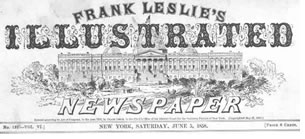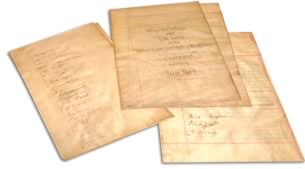

A fledgling profession survives the Civil War by forming a community of architects
by Tony P. Wrenn, Hon. AIA
 They shared a
passion for architecture, those 49 men who founded The American
Institute of Architects. All were architects, learned, successful,
and well known. For decades they had talked about an organization
of architects and had tried twice to organize.
They shared a
passion for architecture, those 49 men who founded The American
Institute of Architects. All were architects, learned, successful,
and well known. For decades they had talked about an organization
of architects and had tried twice to organize.
In 1857 they tried again when Richard Upjohn invited architects to
meet in his New York office, on Tuesday February 23. Thirteen were
present to consider “the propriety of organizing a Society of
Architects.” They agreed “that, with as little delay as
possible, an Association of Architects should be formed ... and
that this meeting take the necessary steps.”
Richard Morris Hunt noted that many distinguished members of the
profession were ignorant of this meeting and “it was advisable
to obtain their support.” Of men suggested, 11 were endorsed
and elected, beginning a process formalized on March 13 when it was
resolved that “The Institute shall consist of professional
architects, who shall be proposed, and elected.”
Full steam ahead
They wasted no time. A committee on a constitution was appointed
and produced a draft. A name was chosen, The American Institute of
Architects, and the constitution adopted. Article 2 read: “The
object of this Institute is to promote the scientific and practical
perfection of its members and elevate the standing of the
Profession.”
On April 13, three weeks after the initial meeting, the group
sought legal recognition and, after lunch at Delmonicos, went to
City Hall “to secure the consent and approbation” of the
courts. Judge Roosevelt, for whom the minutes give no first name,
received them, and, after the papers were filed, remarked that
“he feared not our Institute would fall (sic) for we were
above all others, aware of the necessity for a solid foundation
whereupon to construct an edifice & that consequently he felt
assured that we had laid our cornerstone as on a rock.”
The fledgling AIA had, in less than seven weeks, moved from the
meeting to “consider the propriety of organizing” to
election of its first members, adoption of a constitution, and
legal recognition. On April 15 the constitution was formally
signed. Eventually there were 49 signers, the AIA founders. Upjohn
was elected president and Thomas U. Walter first vice president.
Walter, in accepting, suggested that rather than seeking members,
the Institute “should accomplish something” for it
“had the materials, the means and the talent” to do so.
Others, he suggested, would then seek it out.
Value of community
For the rest of the 1850s and into the 1860s a recurring theme was
the value of individual architects to the community of architects.
On March 1, 1859, Leopold Eidlitz “enumerated the advantages
... derived since the Institute had been established ... &
entreated the members individually to put their shoulders to the
wheel. Almost all that had been accomplished thus far, came
merely from the fact of our being associated.”
 Early members
had to overcome their disinclination to share and the public lack
of knowledge of what an architect did. “The profession was not
appreciated by the public, the fine arts were thought of little
importance, and construction [workers] and carpenters, as practical
men, were thought far superior to the architect,” Glenn Brown
later wrote.
Early members
had to overcome their disinclination to share and the public lack
of knowledge of what an architect did. “The profession was not
appreciated by the public, the fine arts were thought of little
importance, and construction [workers] and carpenters, as practical
men, were thought far superior to the architect,” Glenn Brown
later wrote.
From the beginning, members discussed how to deal with clients,
suppliers, and material testing, while deploring the lack of an
available library on architecture and the absence of any school
teaching architecture. Almost everything we have talked about in
the past 150 years was discussed by members in that first
decade.
On November 16, 1861, as the nation descended into the Civil War,
AIA meetings, due to the “present stress” were suspended.
It was not until March 1864 that regular meetings resumed. A letter
to members announced “The regular meeting of the Institute,
having been intermitted in consequence of the War, recent measures
have been taken to revive them.” Upjohn would write “The
civil war has intervened, deranging every branch of commercial and
professional pursuit; but though a moiety of our existence as a
body, has thus, as it were, been cut away, we feel that we are not
too self-complacent in asserting that we have, by a discreet
handling of the opportunities left us, accomplished for the
profession and the public an amount of benefit which could in no
way have been accomplished without our action.”
A symbol of faith for the country
AIA founders may have fought in the Civil War, though none has been
identified. For one founder though, the war was devastating, for
the practice of Alexander Jackson Davis, who had many projects in
the South, never recovered. Conversely, it catapulted another
founder, Thomas U. Walter, into national prominence. Walter had
been working on the U.S. Capitol for a decade when the war began.
He had designed new Senate and House wings and a new dome, which
would soar above Capitol Hill and be topped by a statue of
“Freedom.”
 Though Capitol
construction was halted at the beginning of the War, Abraham
Lincoln signed, in April 1862, legislation authorizing resumption
of construction, which Walter would control. James Goode wrote in
his 1995 dissertation on Walter, Architecture and
Politics, “The resumption of construction ... had a
profound and unexpected and subtle effect on the faith in the
ultimate success of the Union … The new dome had been widely
publicized, and the Capitol became an American icon. Frank
Leslie’s Illustrated Newspaper, for instance, used
Walter’s new Capitol as part of its title page on every issue
in the late 1850s and the Civil War years. The image of the
Capitol, with its impressive new iron dome, became an elegant and
powerful symbol of the Union ... thousands of Union soldiers used
the image of Walter’s Capitol on their stationery.”
Though Capitol
construction was halted at the beginning of the War, Abraham
Lincoln signed, in April 1862, legislation authorizing resumption
of construction, which Walter would control. James Goode wrote in
his 1995 dissertation on Walter, Architecture and
Politics, “The resumption of construction ... had a
profound and unexpected and subtle effect on the faith in the
ultimate success of the Union … The new dome had been widely
publicized, and the Capitol became an American icon. Frank
Leslie’s Illustrated Newspaper, for instance, used
Walter’s new Capitol as part of its title page on every issue
in the late 1850s and the Civil War years. The image of the
Capitol, with its impressive new iron dome, became an elegant and
powerful symbol of the Union ... thousands of Union soldiers used
the image of Walter’s Capitol on their stationery.”
 The dome rose
as millions of pounds of iron were delivered and hoisted into
place, and the public looked on. On December 2, 1863, the dome was
ready to receive the last section of the statue, its head. With
thousands watching, it was raised into place taking 20 minutes to
ascend. There, atop the dome, the head of “Freedom” was
bolted in and an American flag raised. At its raising, Union
artillery on the Capitol’s east lawn fired 35 times, once for
each of the states in the Union. The 11 forts which surrounded
Washington echoed with 35 salutes each. The hours long ceremony had
special meaning for many for it followed closely President
Lincoln’s signing of the Emancipation Proclamation, freeing
slaves in the rebellious states. The dome and Capitol have become
an internationally known icon of America, among the worlds best
known and most recognized buildings. It has parented state
capitols, city halls, and scores of other domed buildings
nationwide.
The dome rose
as millions of pounds of iron were delivered and hoisted into
place, and the public looked on. On December 2, 1863, the dome was
ready to receive the last section of the statue, its head. With
thousands watching, it was raised into place taking 20 minutes to
ascend. There, atop the dome, the head of “Freedom” was
bolted in and an American flag raised. At its raising, Union
artillery on the Capitol’s east lawn fired 35 times, once for
each of the states in the Union. The 11 forts which surrounded
Washington echoed with 35 salutes each. The hours long ceremony had
special meaning for many for it followed closely President
Lincoln’s signing of the Emancipation Proclamation, freeing
slaves in the rebellious states. The dome and Capitol have become
an internationally known icon of America, among the worlds best
known and most recognized buildings. It has parented state
capitols, city halls, and scores of other domed buildings
nationwide.
 The
architecture community builds
The
architecture community builds
Regular AIA meetings resumed in March 1864, with discussions of
fees, competitions, and the ownership of architectural drawings
along with discussion of publishing a journal to be the organ of
the AIA “and a means of communication with distant
members.” Members discussed, on February 6, 1866, the
“architectural etiquette of advertising and to what extent it
may be done consistently with the dignity of the profession,”
while discussion of the formation of “ancillary branches of
the Institute,” chapters, was ongoing, as were qualifications
for membership, the establishment of a central library or research
facility, and establishing schools to teach architecture.
As the Institute’s first decade ended, Leopold Eidlitz noted
on December 6, 1866, “that one-half of the business of the
city was in the hands of outside architects—nine tenths of it
because the public was not aware of the existence of the Institute
... or that its members were superior to other architects.”
How the Institute could change that situation and give the city,
and country the quality of architecture Walter had given it with
his U.S. Capitol, was a debate that continued in the next
decade.
Copyright 2005 The American Institute of Architects. All rights reserved. Home Page

